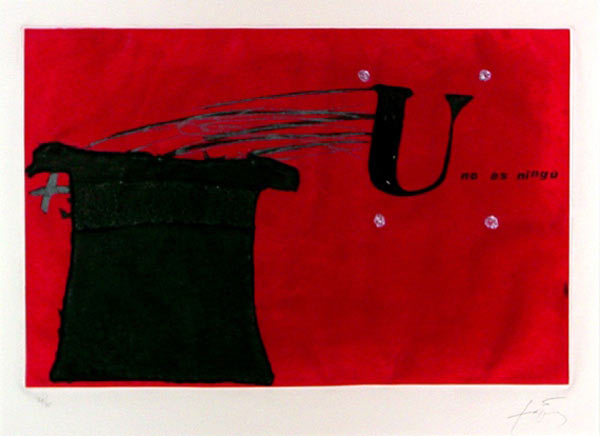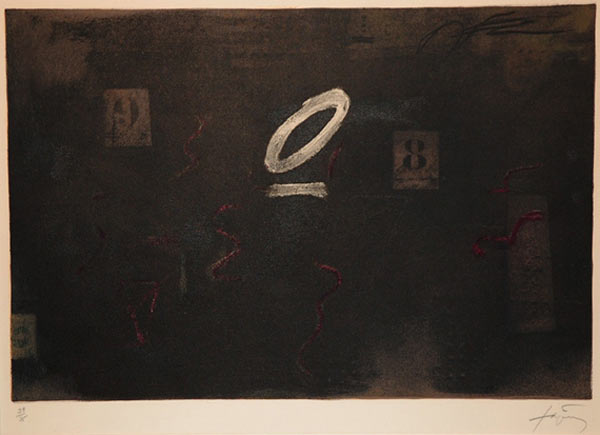Died a well-known Catalan artist Antoni Tapes
One of the largest post-war European masters of fine arts was 88 years old. On his death said Monday Tapesa representing Pace Gallery
Tapes Artist Anthony (Antoni Tàpies), one of the leading representatives of the postwar European art, which works in mysterious abstraction oddly combined with elements of surrealism, died Monday, Feb. 6, in Barcelona at the age of 88 years. This gallery said Pace, a long time representing the artist's work.
| |
Tapes Anthony was born December 13, 1923 in Barcelona. In his youth he experienced the great influence of Surrealism, in particular, authors such as Paul Klee ( Paul Klee), and Joan Miro (Joan Miro). After the Second World War Tapes, along with poet Joan Brosseau (Joan Brossa) founded the art group Dau al Set («Semigranny cube"), as well as the eponymous magazine. group of Catalan artists together, close to Dada and Surrealism, who studied art in his unconscious. During this period he Tapes created abstract works with elements of collage, in which discernible features of the future movement arte povera.
In 1953 the first exhibition of Anthony Tapesa in the U.S.. Being in the States, the artist became acquainted with the works of abstract expressionists. "They" fought "with the canvas, using colors and pressing heavy brush strokes - Tapes recalled his impressions of the works of our American colleagues in an interview with New-York Times in 1995. - And I brought a gray, quiet, quiet, restrained picture. One critic wrote that the paintings that think ».
In 1958, together with the artist Eduardo Chillida (Eduardo Chillida) represented Spain at the Venice Biennale and received the Golden Lion. Four years later, a solo exhibition organized Tapesa Solomon R. Guggenheim Museum.
In 1960, 70 years under the influence of Robert Rauschenberg (Robert Rauschenberg), Anthony began to create surreal Tapes Sculpture in the genre of ready-made. best-known works of this period on the canvas - the same minimalist semi-abstract collages, which include the usual subjects - for example, the work of "sock" in 1971.
 ANTONY TAPES Liberty. 1988 ANTONY TAPES Liberty. 1988 Source:  ANTONY TAPES No one ANTONY TAPES No one Source: |
In 1984, Anthony Tapes created a foundation designed to support research in the field of contemporary art. In 1990, the fund opened a library and museum, the collection which there are about two thousand of his works.
in 1994 in the center of contemporary art is de-Pom in Paris, and in 2000 - at the Museum of Reina Sofia in Madrid have been retrospective Tapesa. with age the artist did not work less, although after 1980 his work was dominated by the familiar characters and stories. In January 2010 there was an exhibition at the gallery Tapesa his son Anthony in Barcelona, and in March the same year of the last 20 years have been exhibited in renovated museum fund in his name. In 2010, King Juan Carlos of Spain bestowed the title of Marquis Anthony Tapesu. Despite poor health and poor eyesight artist continued to do until his death.
in graffiti-like works Tapesa vague at first glance, the strokes coalesce into recognizable outlines of figures and symbols. By the mid-1950s, he found his signature style: was to create a surface covered with spots, scratches, cuts and grooves in the form of letters, numbers and symbols. artist himself considered his work "rock art" on the surface of the collective unconscious of humanity. "horrific and cruel suffering of adult fantasies of my peers, who felt themselves to themselves among the accidents occurred around like themselves poured on the walls around me, - as the artist himself explained the origins of the French art dealer and criticism of Michelle Tape (Michel Tapie) in 1969. - Already in my first papers in 1945 was attended by the elements of street signs and the element of protest - the depressed, the secret, but the living is poured upon the walls of the houses of my native land ».
 ANTONY TAPES Under zero. 1979 ANTONY TAPES Under zero. 1979 Source: 1968 Source: |
Anthony Tapes used a variety of materials: with sand, marble chips and chalk on canvas and boards, who played the role of makeshift walls doors, windows and fences, it is reproduced almost literally brutal reality of the Spanish streets since his dramatic youth, which occurred the Spanish Civil War and the surge of the Catalan nationalist movement.
expressive texture and stark brevity his work gave them a shade of solemnity. critic John Russell (John Russell) spoke of the "aristocratic dignity," radiated the works, which "seemed to be drawn, but drawn from a incredible mix of dirt, sand, earth, dried blood and stone chips ».
Tapes do not like it when it was called abstract artist. Just did not like it and give explanations about the meaning of expressive lines, letters and strokes, which in his works blend into the mysterious text. Fantastic characters, coming from the unconscious, require interpretation, but to help the viewer to read the artist wanted. critic Roland Penrose (Roland Penrose) in his monograph "Tapes" in 1978 called the Spaniard, "the artist, is embodied in the material secret».
He put his art in the sacred meanings, far, however, from the strict spirit received by him in his childhood Catholic upbringing. "In a world where religious symbols continue to lose its meaning, and our habits are becoming more secular, we lose a sense of connection with eternity - Tapes said in 1990, participating in the program BBC "Omnibus." - I think this loss has caused great damage to modern art. arts [for me] - back to basics ».
| Source: |
«I amuse myself that I have something to say - Anthony Tapes said at the opening of the museum in 1990. - If You can not change the world, I want to at least change people's view of him ».
Prepared by Mary Estrova, AI
Source : artinvestment.ru
Permanent link to:
https://artinvestment.ru/en/news/artnews/20120208_tapies.html
https://artinvestment.ru/news/artnews/20120208_tapies.html
© artinvestment.ru, 2025
Attention! All materials of the site and database of auction results ARTinvestment.RU, including illustrated reference information about the works sold at auctions, are intended for use exclusively for informational, scientific, educational and cultural purposes in accordance with Art. 1274 of the Civil Code. Use for commercial purposes or in violation of the rules established by the Civil Code of the Russian Federation is not allowed. ARTinvestment.RU is not responsible for the content of materials submitted by third parties. In case of violation of the rights of third parties, the site administration reserves the right to remove them from the site and from the database on the basis of an application from an authorized body.

